Basic Connections
Bolted Connections
Bolt Types. There are two common types of bolts used in bolted connections, Hex Head bolts and Tension Control (TC) bolts. Rivets might be found in historic projects but they are no longer used in contemporary construction. Where historic projects that use rivets are being renovated or refurbished, TC bolts can be used as their round head mimics the appearance of the rivet head. Various types of steel can be used as the bolt material. High strength steel is most commonly used for its superior load carrying capacity. Stainless steel will be used in applications where appearance is important and weather is an issue. Galvanized bolts are used in conjunction with galvaninzed steel projects.
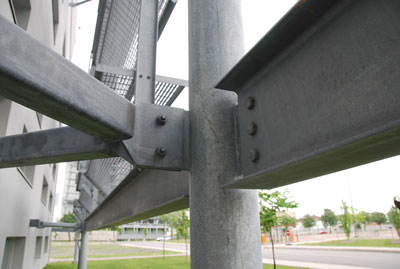 |
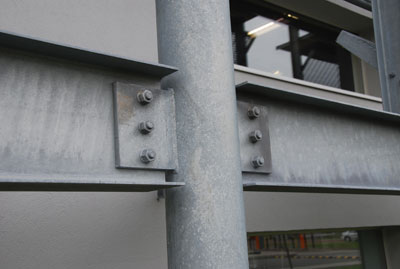 |
Regular Hex Head bolts are being used on the connections for this shading screen. Here the system uses galvanized steel for durability and minimized maintenance. For concealed structural steel it does not matter on which face the head of the bolt would appear. On AESS steel it is reasonable to ask that all the heads be placed on a certain side to improve the aesthetic of the joint. |
The Hex Head bolt requires access from both sides of the connection for tightening. Here we can see the bolts on the rear face.Washers are used between the nut and the plate to assist in distributing the load between the nut and the plate. This image shows the front face of the sun screen. It might be preferable to have placed the heads on this side of the connection as there was adequate space behind for access for tightening. |
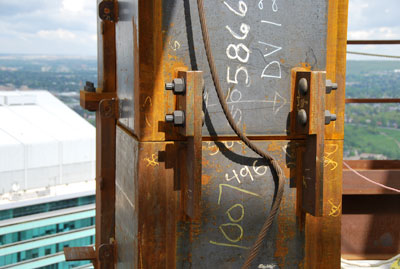 |
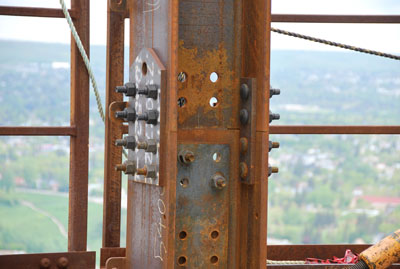 |
Tension Control (TC) bolts are being used in this column splice as part of a temporary bracing system. The plate tabs that have been welded to the square columns are used to both align and hold the column sections in place until the welding is complete. Tension Control bolts do not require access to both sides of the connection to accomplish tightening. A proprietary device is used to tighten the nut/thread side of the bolt. Once tight the slender end of the bolt is snapped off by the tightening device. This is a good example of a welded butt joint. |
This column splice is bolted. The side plates with the hole at the top are used by the crane to lift the member into place. The central plate on the web is bolted to the member prior to lifting. Now it will be moved, repositioned and bolted into place with TC bolts. This assists in keeping the "parts" of the connection in the right place during the erection process. Additional plates are placed beneath the heads of the TC bolts for added strength to the flanges of the beam. This is a good example of a butt joint. |
Erection Process. The members are lifted by the crane to the location. Ironworkers receive the structural elements and guide them into position, so that the bolt holes align. When members are erected that use bolted connections, most of the plates angles that are being used to secure the connection have been attached to the receiving element, often at the shop, prior to shipping. The site work will involve lining up the members, adding shims if necessary to secure alignment and completing the bolting.
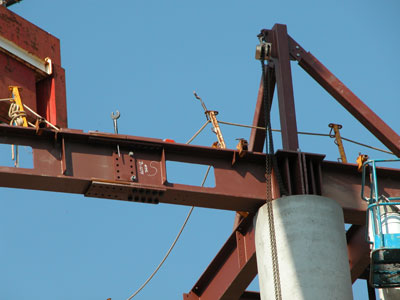 |
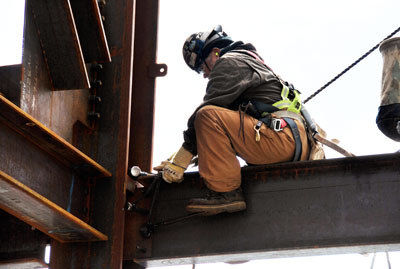 |
A slug wrench is inserted to assist in aligning the bolt holes. The slug wrench is left in place while a couple of initial bolts are inserted to provide temporary stability to the connection. |
An ironworker inserting bolts while the slug wrenches are still holding the connection in place. |
Tightening. When bolts are initially inserted during erection they are typically hand tightened by the ironworkers. A few bolts will be inserted to the point of achieving adequate stability so that the crane can be released. A secondary crew will then follow behind and clean up the joints - installing the balance of the bolts required to complete the connection. Once these are installed, tightening takes place. Bolts have to be tightened properly in order to achieve full capacity when the connection is loaded.
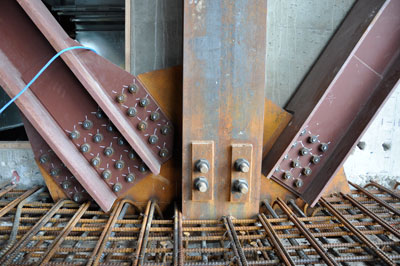 |
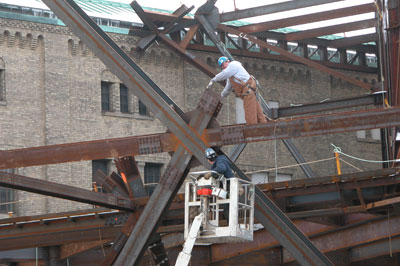 |
Bolt tightening can be accomplished in different ways. Here the "turn of nut method" is being used with regular Hex Head bolts. After the bolts are snug-tightened, an additional fraction of a turn is applied to the nut to achieve the desired tension in the bolt. Usually, a worker will draw a chalk mark across the diameter of the bolt before applying the extra turn. Hence, an inspector can check if the fraction of turn was observed. In many conditions, only an additional third of a turn is needed to achieve the desirable pretension in the bolt. This method is not used with TC bolts. |
Bolted connections were used throughout the Addition to the Royal Ontario Museum during site erection. This allowed for much easier site assembly. Once the diagrid elements were initially erected, a secondary team of ironworkers would complete the bolting task, allowing the primary team to move on to attach more members. All of the difficult geometries were welded in the fabrication shop. |
